A model for real - time concurrent interaction protocols in component interfaces
Component-based system architectures
have been an efficient divide-and-conquer
design technique for the development of
complex real-time embedded systems. A key
role in this technique is component interface
modeling and specification. There have been
many significant progresses towards a
comprehensive theory for interfaces, see for
example [2, , 3, 5, 6, 7]. In those works
different aspects of interfaces have been
modeled and specified such as interaction
protocols, contracts, concurrency, relations,
synchnony and asynchrony. An approach that
integrates all those aspects has been introduced
in [4]. However, there has not been an intuitive
and powerful model for real-time interaction
protocols. This kind of model plays an crucial
role in systems where a service from a
component may take long time to finish.
An interaction protocol specified in the
interface of a component is a precondition on
the temporal order on the use of services from
the component. Fail to satisfy this precondition
may lead to a system deadlock [2]. In real-time
systems, when a service from a component
takes a considerable time to carry out, too
frequently calling to this service may lead to the
error state too. So, we need to specify the
minimum duration between two consecutive
calls to the services that takes time, and this
also plays a role of precondition on the
consecutive calls to those services in the
interaction protocols. Another possibility that
we need to consider when specifying this kind
of time constraints is that a component may be
able to provide services in parallel. In this case,
time constraints do not apply to
concurrent services.

Trang 1
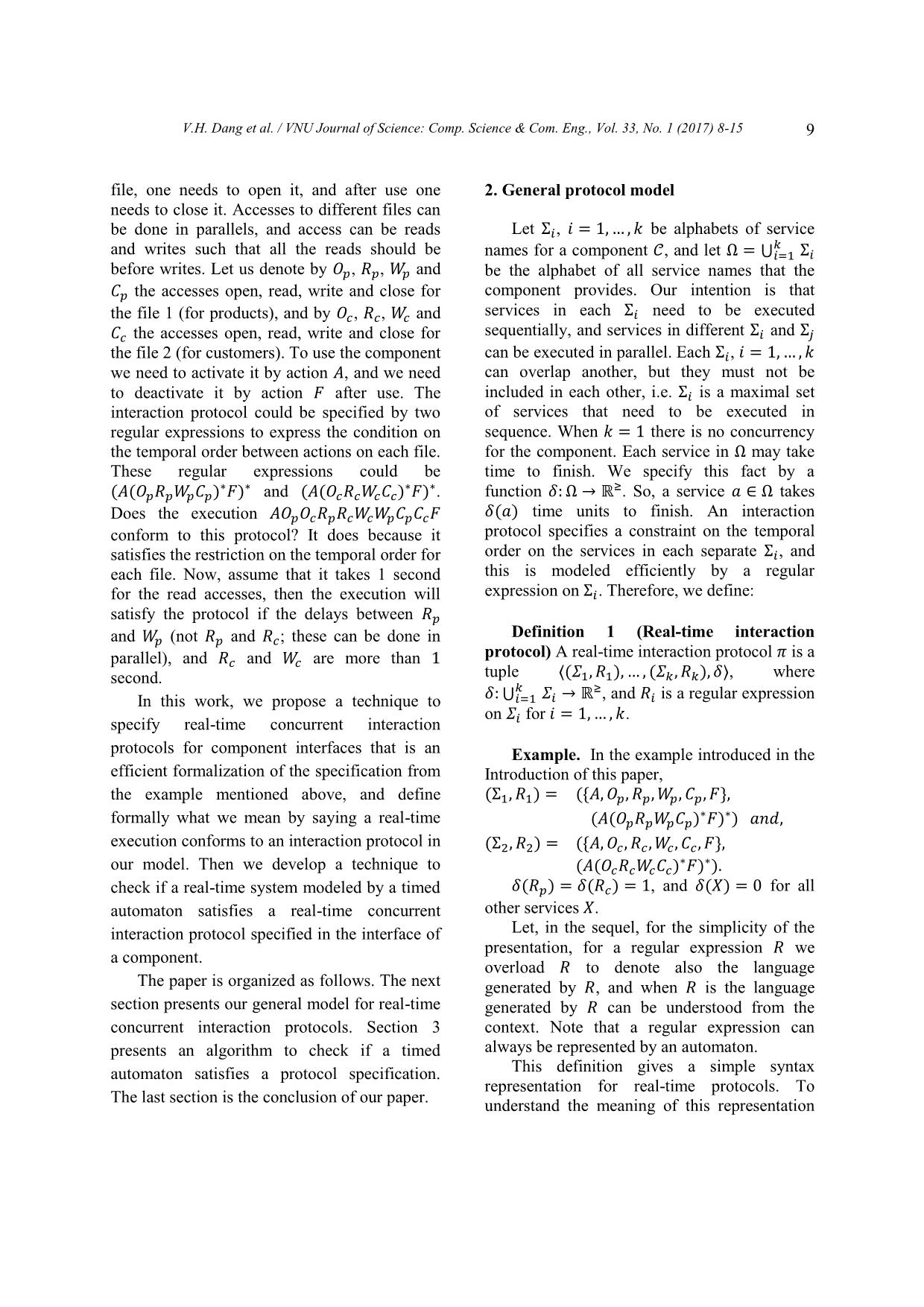
Trang 2
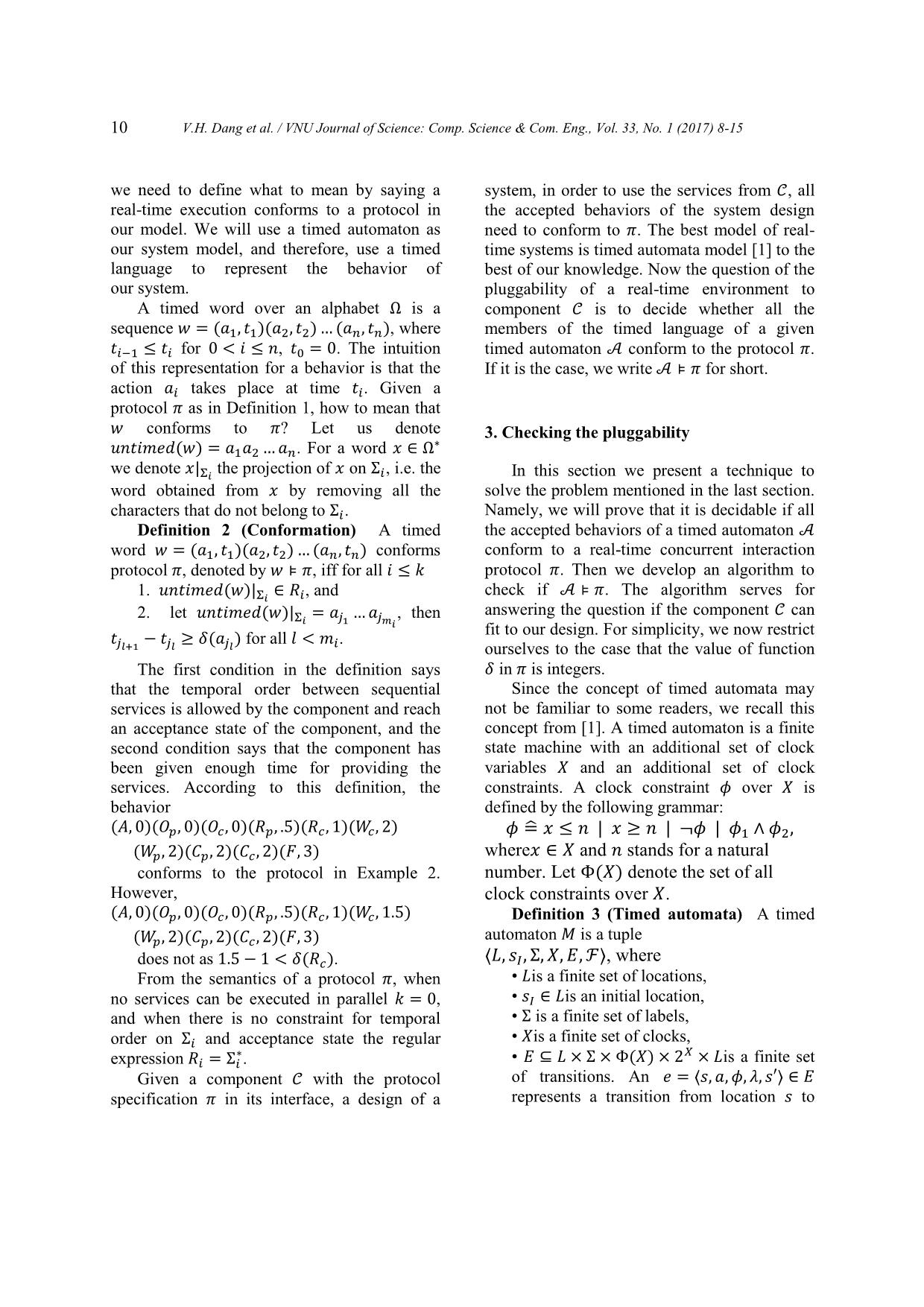
Trang 3
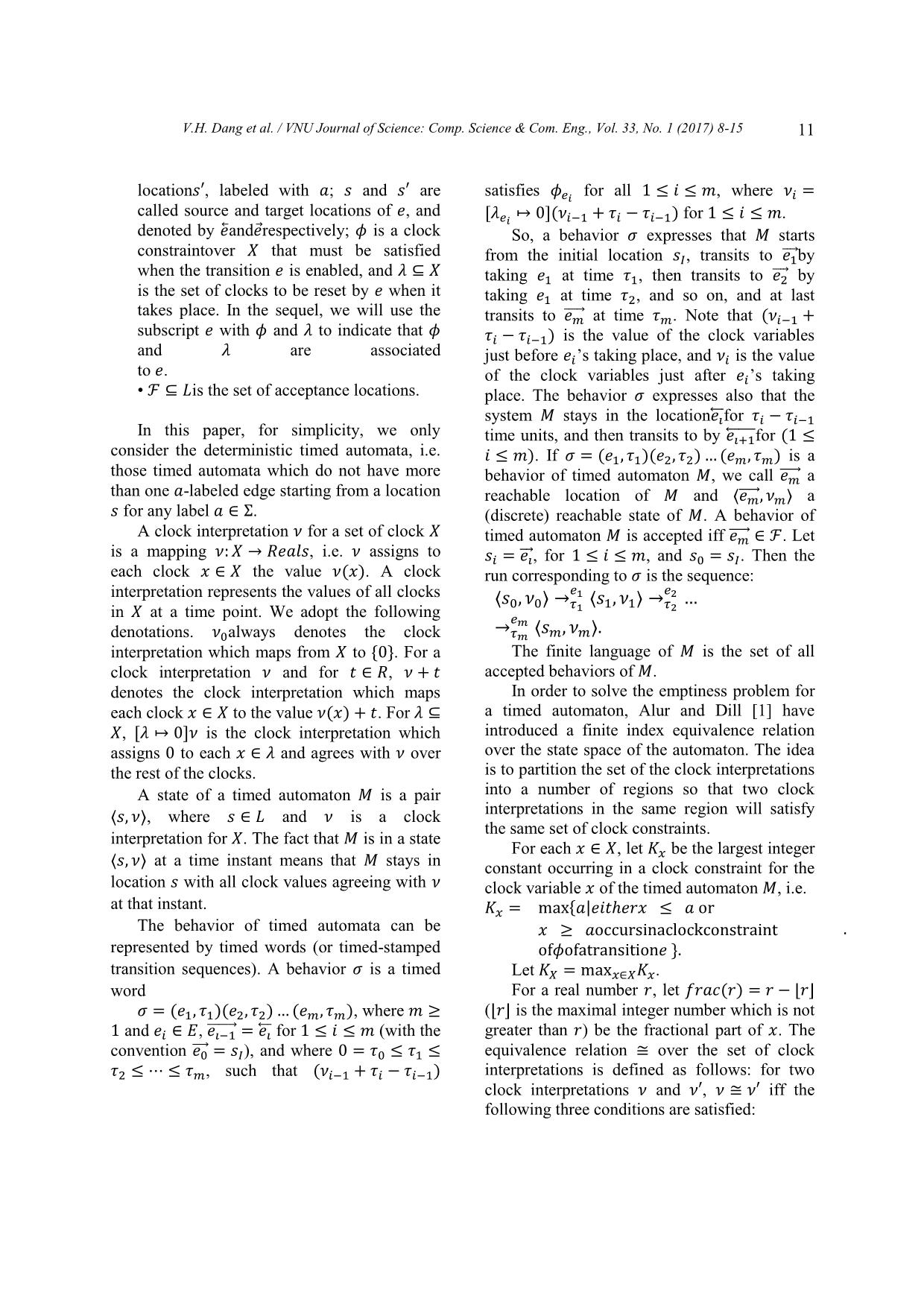
Trang 4
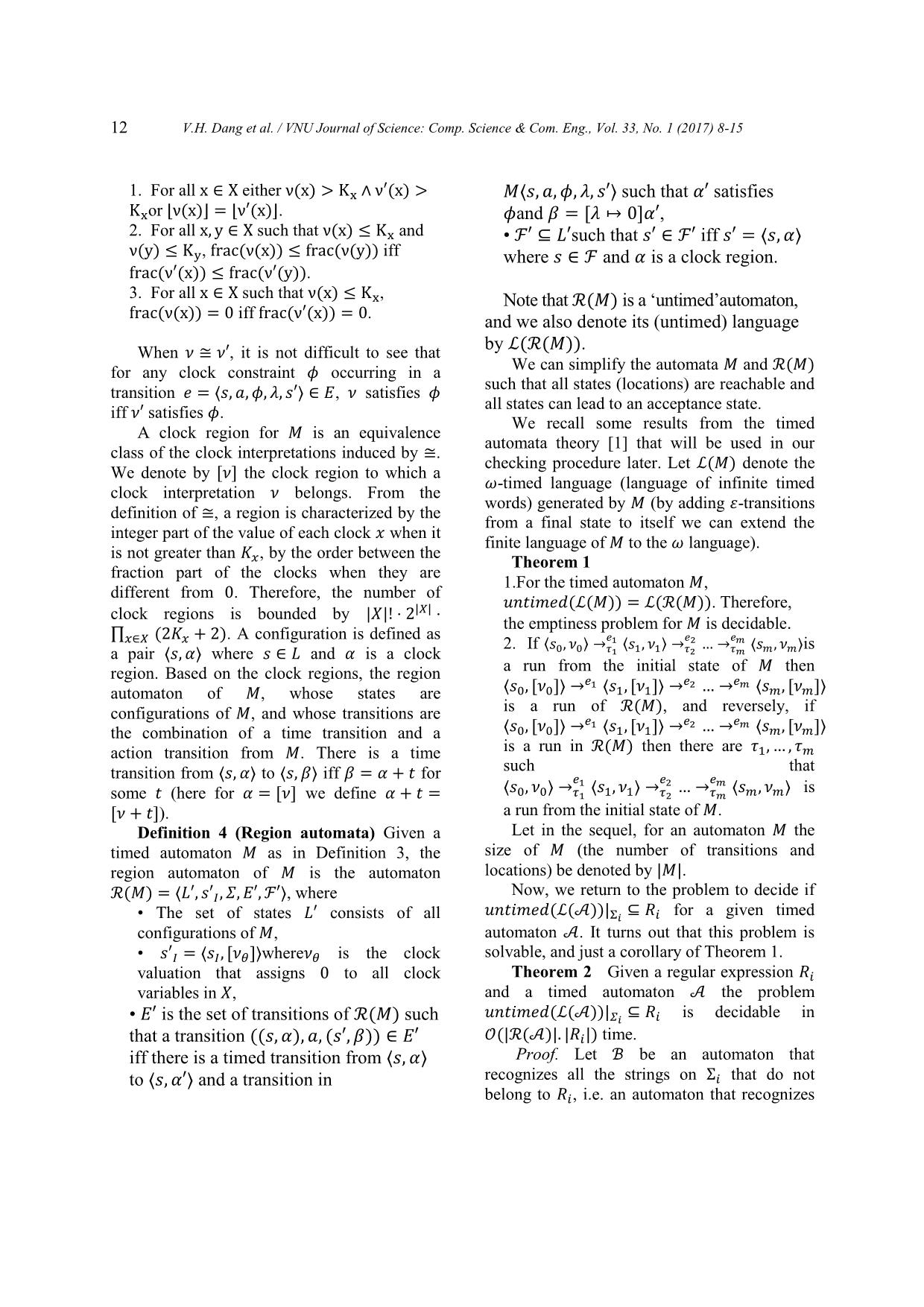
Trang 5
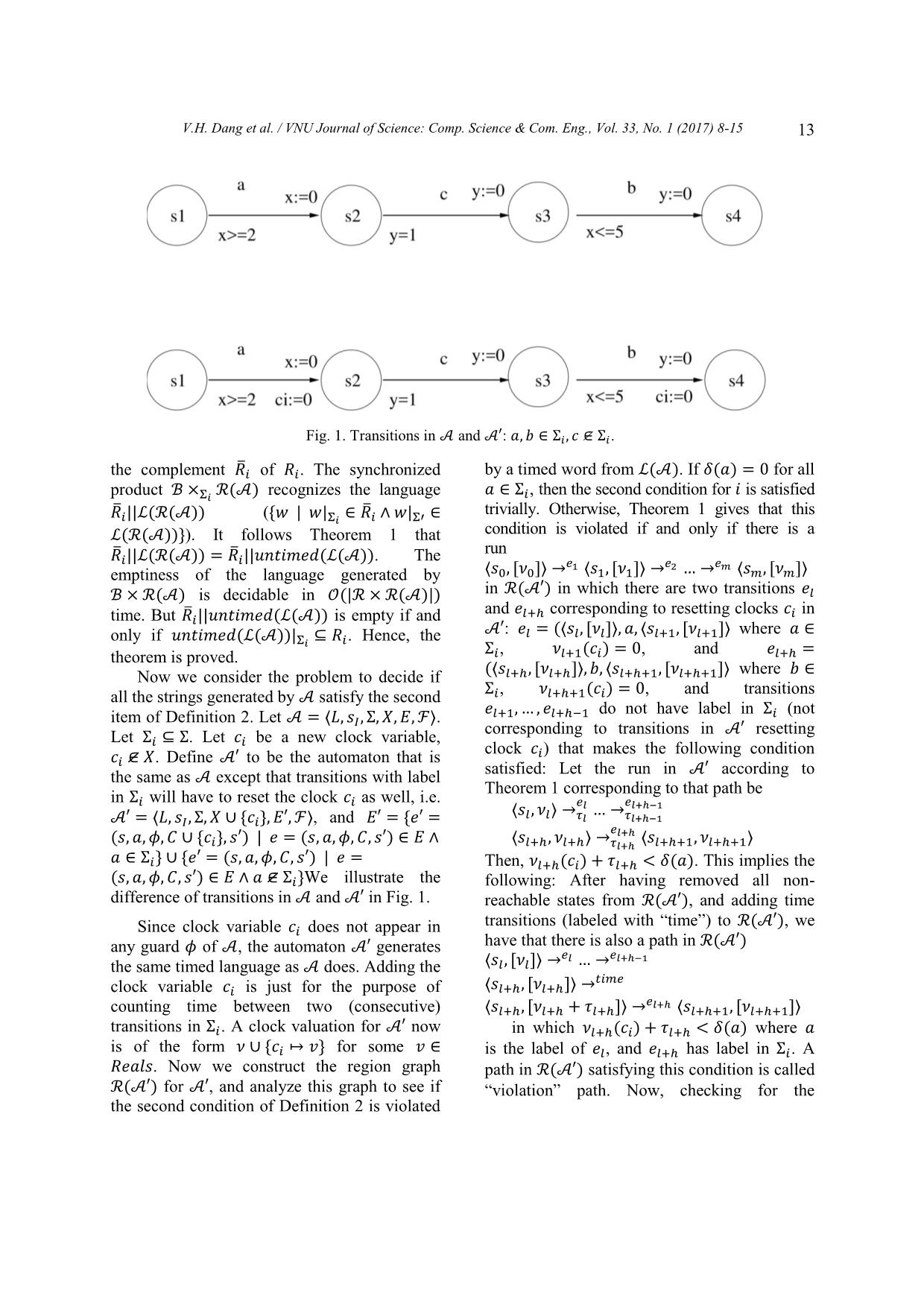
Trang 6
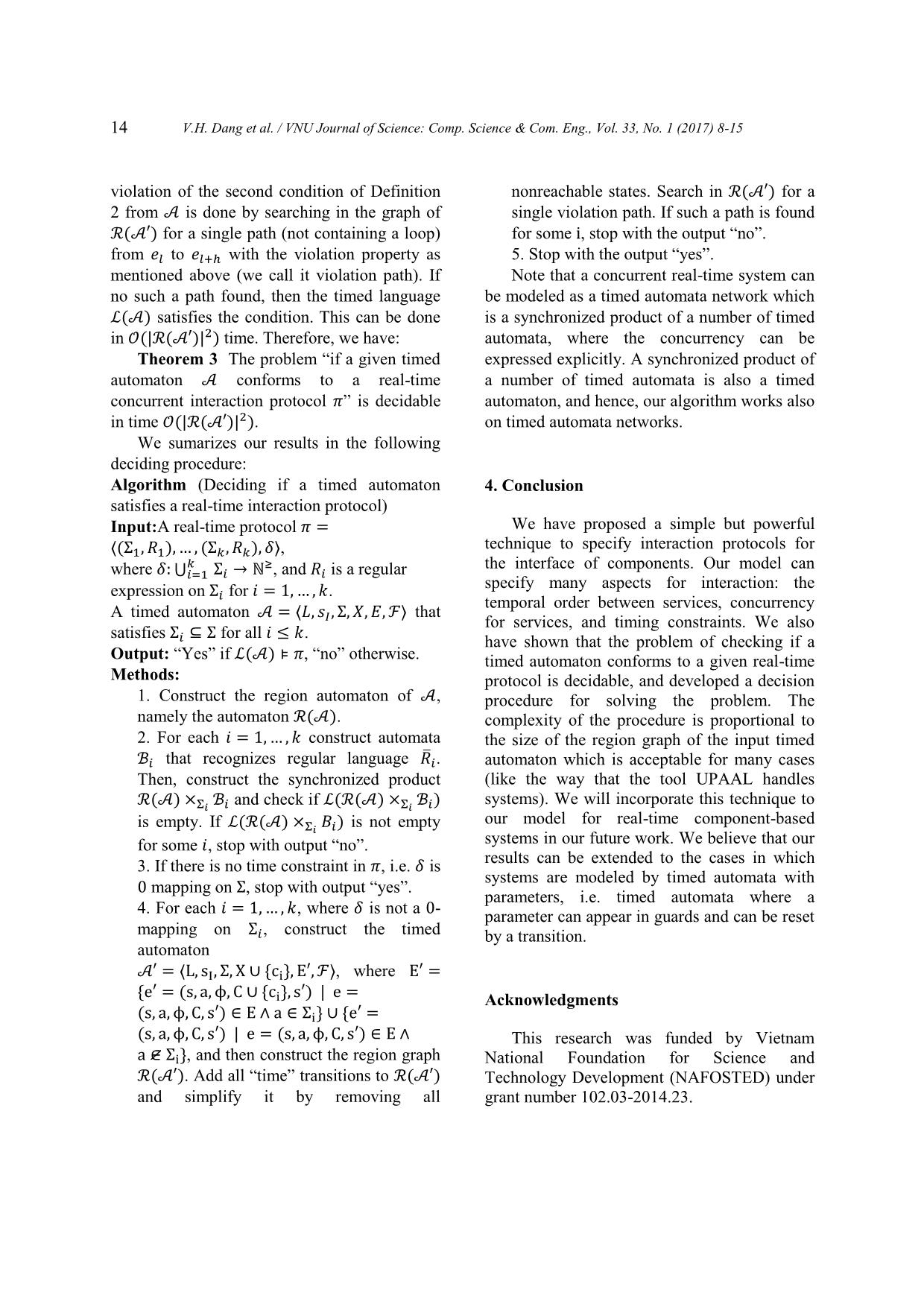
Trang 7

Trang 8
Tóm tắt nội dung tài liệu: A model for real - time concurrent interaction protocols in component interfaces
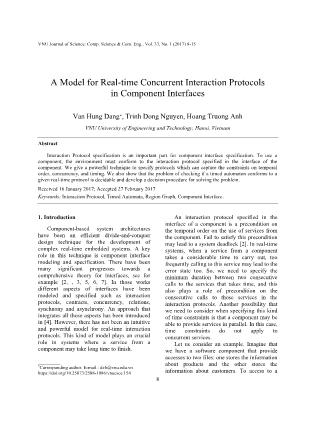
he set of clocks to be reset by 푒 when it
taking 푒1 at time 휏2, and so on, and at last
takes place. In the sequel, we will use the
transits to 푒⃗⃗⃗ ⃗⃗⃗ at time 휏 . Note that (휈푖−1 +
subscript 푒 with 휙 and 휆 to indicate that 휙
휏푖 − 휏푖−1) is the value of the clock variables
and 휆 are associated
just before 푒푖’s taking place, and 휈푖 is the value
to 푒.
of the clock variables just after 푒푖’s taking
• ℱ ⊆ 퐿is the set of acceptance locations. place. The behavior 휎 expresses also that the
system stays in the location푒⃖⃗⃗푖⃗for 휏푖 − 휏푖−1
In this paper, for simplicity, we only
time units, and then transits to by 푒⃖⃗푖⃗⃗+⃗⃗⃗1⃗for (1 ≤
consider the deterministic timed automata, i.e.
𝑖 ≤ ). If 휎 = (푒1, 휏1)(푒2, 휏2) (푒 , 휏 ) is a
those timed automata which do not have more
behavior of timed automaton , we call 푒⃗⃗⃗ ⃗⃗⃗ a
than one -labeled edge starting from a location
reachable location of and 〈푒⃗⃗⃗ ⃗⃗⃗, 휈 〉 a
푠 for any label ∈ Σ. (discrete) reachable state of . A behavior of
A clock interpretation 휈 for a set of clock
timed automaton is accepted iff 푒⃗⃗⃗ ⃗⃗⃗ ∈ ℱ. Let
is a mapping 휈: → 푅푒 푙푠, i.e. 휈 assigns to
푠푖 = 푒⃗⃗⃗⃗푖, for 1 ≤ 𝑖 ≤ , and 푠0 = 푠 . Then the
each clock ∈ the value 휈( ). A clock run corresponding to 휎 is the sequence:
interpretation represents the values of all clocks 푒1 푒2
〈푠0, 휈0〉 →휏 〈푠1, 휈1〉 →휏
in at a time point. We adopt the following 1 2
→푒 〈푠 , 휈 〉.
denotations. 휈0always denotes the clock 휏
interpretation which maps from to {0}. For a The finite language of is the set of all
clock interpretation 휈 and for 푡 ∈ 푅, 휈 + 푡 accepted behaviors of .
denotes the clock interpretation which maps In order to solve the emptiness problem for
each clock ∈ to the value 휈( ) + 푡. For 휆 ⊆ a timed automaton, Alur and Dill [1] have
, [휆 ↦ 0]휈 is the clock interpretation which introduced a finite index equivalence relation
assigns 0 to each ∈ 휆 and agrees with 휈 over over the state space of the automaton. The idea
the rest of the clocks. is to partition the set of the clock interpretations
A state of a timed automaton is a pair into a number of regions so that two clock
〈푠, 휈〉, where 푠 ∈ 퐿 and 휈 is a clock interpretations in the same region will satisfy
the same set of clock constraints.
interpretation for . The fact that is in a state
For each ∈ , let 퐾 be the largest integer
〈푠, 휈〉 at a time instant means that stays in constant occurring in a clock constraint for the
location 푠 with all clock values agreeing with 휈 clock variable of the timed automaton , i.e.
at that instant.
퐾 = max{ |푒𝑖푡ℎ푒 ≤ or
The behavior of timed automata can be ≥ occursinaclockconstraint .
represented by timed words (or timed-stamped of휙ofatransition푒 }.
transition sequences). A behavior 휎 is a timed Let 퐾 = max ∈ 퐾 .
word For a real number , let ( ) = − ⌊ ⌋
휎 = (푒1, 휏1)(푒2, 휏2) (푒 , 휏 ), where ≥ (⌊ ⌋ is the maximal integer number which is not
1 and 푒푖 ∈ , 푒⃗⃗⃗푖⃗−⃗⃗⃗1⃗ = 푒⃖⃗⃗푖⃗ for 1 ≤ 𝑖 ≤ (with the greater than ) be the fractional part of . The
convention 푒⃗⃗⃗0⃗ = 푠 ), and where 0 = 휏0 ≤ 휏1 ≤ equivalence relation ≅ over the set of clock
휏2 ≤ ⋯ ≤ 휏 , such that (휈푖−1 + 휏푖 − 휏푖−1) interpretations is defined as follows: for two
clock interpretations 휈 and 휈′, 휈 ≅ 휈′ iff the
following three conditions are satisfied:
12 V.H. Dang et al. / VNU Journal of Science: Comp. Science & Com. Eng., Vol. 33, No. 1 (2017) 8-15
1. For all x ∈ X either ν(x) > Kx ∧ ν′(x) > 〈푠, , 휙, 휆, 푠′〉 such that 훼′ satisfies
Kxor ⌊ν(x)⌋ = ⌊ν′(x)⌋. 휙and 훽 = [휆 ↦ 0]훼′,
2. For all x, y ∈ X such that ν(x) ≤ Kx and • ℱ′ ⊆ 퐿′such that 푠′ ∈ ℱ′ iff 푠′ = 〈푠, 훼〉
ν(y) ≤ Ky, frac(ν(x)) ≤ frac(ν(y)) iff where 푠 ∈ ℱ and 훼 is a clock region.
frac(ν′(x)) ≤ frac(ν′(y)).
3. For all x ∈ X such that ν(x) ≤ Kx, Note that ℛ( ) is a ‘untimed’automaton,
frac(ν(x)) = 0 iff frac(ν′(x)) = 0. and we also denote its (untimed) language
When 휈 ≅ 휈′, it is not difficult to see that by ℒ(ℛ( )).
for any clock constraint 휙 occurring in a We can simplify the automata and ℛ( )
such that all states (locations) are reachable and
transition 푒 = 〈푠, , 휙, 휆, 푠′〉 ∈ , 휈 satisfies 휙
all states can lead to an acceptance state.
iff 휈′ satisfies 휙.
We recall some results from the timed
A clock region for is an equivalence
automata theory [1] that will be used in our
class of the clock interpretations induced by ≅.
checking procedure later. Let ℒ( ) denote the
We denote by [휈] the clock region to which a
휔-timed language (language of infinite timed
clock interpretation 휈 belongs. From the
words) generated by (by adding 휀-transitions
definition of ≅, a region is characterized by the
from a final state to itself we can extend the
integer part of the value of each clock when it
finite language of to the 휔 language).
is not greater than 퐾 , by the order between the
Theorem 1
fraction part of the clocks when they are
1.For the timed automaton ,
different from 0. Therefore, the number of
푛푡𝑖 푒 (ℒ( )) = ℒ(ℛ( )). Therefore,
clock regions is bounded by | |! ⋅ 2| | ⋅
the emptiness problem for is decidable.
∏ (2퐾 + 2). A configuration is defined as
∈ 2. If 〈푠 , 휈 〉 →푒1 〈푠 , 휈 〉 →푒2 →푒 〈푠 , 휈 〉is
a pair 〈푠, 훼〉 where 푠 ∈ 퐿 and 훼 is a clock 0 0 휏1 1 1 휏2 휏
region. Based on the clock regions, the region a run from the initial state of then
푒1 푒2 푒
automaton of , whose states are 〈푠0, [휈0]〉 → 〈푠1, [휈1]〉 → → 〈푠 , [휈 ]〉
configurations of , and whose transitions are is a run of ℛ( ), and reversely, if
푒1 푒2 푒
the combination of a time transition and a 〈푠0, [휈0]〉 → 〈푠1, [휈1]〉 → → 〈푠 , [휈 ]〉
action transition from . There is a time is a run in ℛ( ) then there are 휏1, , 휏
transition from 〈푠, 훼〉 to 〈푠, 훽〉 iff 훽 = 훼 + 푡 for such that
〈푠 , 휈 〉 →푒1 〈푠 , 휈 〉 →푒2 →푒 〈푠 , 휈 〉 is
some 푡 (here for 훼 = [휈] we define 훼 + 푡 = 0 0 휏1 1 1 휏2 휏
[휈 + 푡]). a run from the initial state of .
Definition 4 (Region automata) Given a Let in the sequel, for an automaton the
timed automaton as in Definition 3, the size of (the number of transitions and
region automaton of is the automaton locations) be denoted by | |.
ℛ( ) = 〈퐿′, 푠′ , 훴, ′, ℱ′〉, where Now, we return to the problem to decide if
• The set of states 퐿′ consists of all 푛푡𝑖 푒 (ℒ(𝒜))|Σ𝑖 ⊆ 푅푖 for a given timed
configurations of , automaton 𝒜. It turns out that this problem is
• 푠′ = 〈푠 , [휈휃]〉where휈휃 is the clock solvable, and just a corollary of Theorem 1.
valuation that assigns 0 to all clock Theorem 2 Given a regular expression 푅푖
variables in , and a timed automaton 𝒜 the problem
• ′ is the set of transitions of ℛ( ) such 푛푡𝑖 푒 (ℒ(𝒜))|훴𝑖 ⊆ 푅푖 is decidable in
that a transition ((푠, 훼), , (푠′, 훽)) ∈ ′ 풪(|ℛ(𝒜)|. |푅푖|) time.
iff there is a timed transition from 〈푠, 훼〉 Proof. Let ℬ be an automaton that
to 〈푠, 훼′〉 and a transition in recognizes all the strings on Σ푖 that do not
belong to 푅푖, i.e. an automaton that recognizes
V.H. Dang et al. / VNU Journal of Science: Comp. Science & Com. Eng., Vol. 33, No. 1 (2017) 8-15 13
Fig. 1. Transitions in 𝒜 and 𝒜′: , ∈ Σ푖, ∈ Σ푖.
the complement 푅̅푖 of 푅푖. The synchronized by a timed word from ℒ(𝒜). If 훿( ) = 0 for all
, then the second condition for is satisfied
product ℬ ×Σ𝑖 ℛ(𝒜) recognizes the language ∈ Σ푖 𝑖
̅ ̅ trivially. Otherwise, Theorem 1 gives that this
푅푖||ℒ(ℛ(𝒜)) ({푤 | 푤|Σ𝑖 ∈ 푅푖 ∧ 푤|Σ′ ∈
ℒ(ℛ(𝒜))}). It follows Theorem 1 that condition is violated if and only if there is a
run
푅̅푖||ℒ(ℛ(𝒜)) = 푅̅푖|| 푛푡𝑖 푒 (ℒ(𝒜)). The
푒1 푒2 푒
emptiness of the language generated by 〈푠0, [휈0]〉 → 〈푠1, [휈1]〉 → → 〈푠 , [휈 ]〉
ℬ × ℛ(𝒜) is decidable in 풪(|ℛ × ℛ(𝒜)|) in ℛ(𝒜′) in which there are two transitions 푒푙
and 푒푙+ℎ corresponding to resetting clocks 푖 in
time. But 푅̅푖|| 푛푡𝑖 푒 (ℒ(𝒜)) is empty if and
only if 푛푡𝑖 푒 (ℒ(𝒜))| ⊆ 푅 . Hence, the 𝒜′: 푒푙 = (〈푠푙, [휈푙]〉, , 〈푠푙+1, [휈푙+1]〉 where ∈
Σ𝑖 푖 Σ , 휈 ( ) = 0, and 푒 =
theorem is proved. 푖 푙+1 푖 푙+ℎ
where
Now we consider the problem to decide if (〈푠푙+ℎ, [휈푙+ℎ]〉, , 〈푠푙+ℎ+1, [휈푙+ℎ+1]〉 ∈
Σ , 휈 ( ) = 0, and transitions
all the strings generated by 𝒜 satisfy the second 푖 푙+ℎ+1 푖
푒 , , 푒 do not have label in Σ (not
item of Definition 2. Let 𝒜 = 〈퐿, 푠 , Σ, , , ℱ〉. 푙+1 푙+ℎ−1 푖
corresponding to transitions in 𝒜′ resetting
Let Σ ⊆ Σ. Let be a new clock variable,
푖 푖 clock ) that makes the following condition
∈ . Define 𝒜′ to be the automaton that is 푖
푖 satisfied: Let the run in 𝒜′ according to
the same as 𝒜 except that transitions with label
Theorem 1 corresponding to that path be
in Σ푖 will have to reset the clock 푖 as well, i.e. 푒푙 푒푙+ℎ−1
〈푠푙, 휈푙〉 →휏 →휏
𝒜′ = 〈퐿, 푠 , Σ, ∪ { 푖}, ′, ℱ〉, and ′ = {푒′ = 푙 푙+ℎ−1
(푠, , 휙, ∪ { }, 푠′) | 푒 = (푠, , 휙, , 푠′) ∈ ∧ 〈푠 , 휈 〉 →푒푙+ℎ 〈푠 , 휈 〉
푖 푙+ℎ 푙+ℎ 휏푙+ℎ 푙+ℎ+1 푙+ℎ+1
∈ Σ푖} ∪ {푒′ = (푠, , 휙, , 푠′) | 푒 = Then, 휈푙+ℎ( 푖) + 휏푙+ℎ < 훿( ). This implies the
(푠, , 휙, , 푠′) ∈ ∧ ∈ Σ푖}We illustrate the following: After having removed all non-
difference of transitions in 𝒜 and 𝒜′ in Fig. 1. reachable states from ℛ(𝒜′), and adding time
transitions (labeled with “time”) to ℛ(𝒜′), we
Since clock variable 푖 does not appear in
any guard 휙 of 𝒜, the automaton 𝒜′ generates have that there is also a path in ℛ(𝒜′)
푒푙 푒푙+ℎ−1
the same timed language as 𝒜 does. Adding the 〈푠푙, [휈푙]〉 → →
푡푖 푒
clock variable 푖 is just for the purpose of 〈푠푙+ℎ, [휈푙+ℎ]〉 →
푒푙+ℎ
counting time between two (consecutive) 〈푠푙+ℎ, [휈푙+ℎ + 휏푙+ℎ]〉 → 〈푠푙+ℎ+1, [휈푙+ℎ+1]〉
transitions in Σ푖. A clock valuation for 𝒜′ now in which 휈푙+ℎ( 푖) + 휏푙+ℎ < 훿( ) where
is of the form 휈 ∪ { 푖 ↦ 푣} for some 푣 ∈ is the label of 푒푙, and 푒푙+ℎ has label in Σ푖. A
푅푒 푙푠. Now we construct the region graph path in ℛ(𝒜′) satisfying this condition is called
ℛ(𝒜′) for 𝒜′, and analyze this graph to see if “violation” path. Now, checking for the
the second condition of Definition 2 is violated
14 V.H. Dang et al. / VNU Journal of Science: Comp. Science & Com. Eng., Vol. 33, No. 1 (2017) 8-15
violation of the second condition of Definition nonreachable states. Search in ℛ(𝒜′) for a
2 from 𝒜 is done by searching in the graph of single violation path. If such a path is found
ℛ(𝒜′) for a single path (not containing a loop) for some i, stop with the output “no”.
from 푒푙 to 푒푙+ℎ with the violation property as 5. Stop with the output “yes”.
mentioned above (we call it violation path). If Note that a concurrent real-time system can
no such a path found, then the timed language be modeled as a timed automata network which
ℒ(𝒜) satisfies the condition. This can be done is a synchronized product of a number of timed
in 풪(|ℛ(𝒜′)|2) time. Therefore, we have: automata, where the concurrency can be
Theorem 3 The problem “if a given timed expressed explicitly. A synchronized product of
automaton 𝒜 conforms to a real-time a number of timed automata is also a timed
concurrent interaction protocol ” is decidable automaton, and hence, our algorithm works also
in time 풪(|ℛ(𝒜′)|2). on timed automata networks.
We sumarizes our results in the following
deciding procedure:
Algorithm (Deciding if a timed automaton 4. Conclusion
satisfies a real-time interaction protocol)
Input:A real-time protocol = We have proposed a simple but powerful
technique to specify interaction protocols for
〈(Σ1, 푅1), , (Σ , 푅 ), 훿〉,
≥ the interface of components. Our model can
where 훿: ⋃푖=1 Σ푖 → ℕ , and 푅푖 is a regular
expression on Σ for 𝑖 = 1, , . specify many aspects for interaction: the
푖 temporal order between services, concurrency
A timed automaton 𝒜 = 〈퐿, 푠 , Σ, , , ℱ〉 that
for services, and timing constraints. We also
satisfies Σ ⊆ Σ for all 𝑖 ≤ .
푖 have shown that the problem of checking if a
Output: “Yes” if ℒ(𝒜) ⊧ , “no” otherwise. timed automaton conforms to a given real-time
Methods: protocol is decidable, and developed a decision
1. Construct the region automaton of 𝒜, procedure for solving the problem. The
namely the automaton ℛ(𝒜). complexity of the procedure is proportional to
2. For each 𝑖 = 1, , construct automata the size of the region graph of the input timed
ℬ푖 that recognizes regular language 푅̅푖. automaton which is acceptable for many cases
Then, construct the synchronized product (like the way that the tool UPAAL handles
systems). We will incorporate this technique to
ℛ(𝒜) ×Σ𝑖 ℬ푖 and check if ℒ(ℛ(𝒜) ×Σ𝑖 ℬ푖)
our model for real-time component-based
is empty. If ℒ(ℛ(𝒜) ×Σ𝑖 푖) is not empty
for some 𝑖, stop with output “no”. systems in our future work. We believe that our
3. If there is no time constraint in , i.e. 훿 is results can be extended to the cases in which
systems are modeled by timed automata with
0 mapping on Σ, stop with output “yes”.
parameters, i.e. timed automata where a
4. For each , where is not a -
𝑖 = 1, , 훿 0 parameter can appear in guards and can be reset
mapping on Σ푖, construct the timed by a transition.
automaton
𝒜′ = 〈L, sI, Σ, X ∪ {ci}, E′, ℱ〉, where E′ =
{e′ = (s, a, ϕ, C ∪ {ci}, s′) | e = Acknowledgments
(s, a, ϕ, C, s′) ∈ E ∧ a ∈ Σi} ∪ {e′ =
(s, a, ϕ, C, s′) | e = (s, a, ϕ, C, s′) ∈ E ∧ This research was funded by Vietnam
a ∈ Σi}, and then construct the region graph National Foundation for Science and
ℛ(𝒜′). Add all “time” transitions to ℛ(𝒜′) Technology Development (NAFOSTED) under
and simplify it by removing all grant number 102.03-2014.23.
V.H. Dang et al. / VNU Journal of Science: Comp. Science & Com. Eng., Vol. 33, No. 1 (2017) 8-15 15
References He on the Occasion of His 70th Birthday,
pages 136-150, 2013.
[1] R. Alur and D.L. Dill. A Theory of Timed [5] Hung Ledang and Dang Van Hung. Timing
Automata. Theoretical Computer Science, and concurrency specification in component-
pages 183-235, 1994. based real-time embedded systems
[2] Luca de Alfaro and Thomas A. Henzinger. development. In TASE, pages 293-304.
Interface Automata. In ACM Symposium on IEEE Computer Society, 2007.
Foundation of Software Engineering (FSE), 2001. [6] Stavros Tripakis, Ben Lickly, Thomas A.
[3] Jifeng He, Zhiming Liu, and Xiaoshan Li. Henzinger, and Edward A. Lee. On relational
rCOS: A refinement calculus of object systems. interfaces. In EMSOFT’09, pages 67-76.
Theor. Comput. Sci., 365(1-2):109-142, 2006. ACM, 2009.
UNU-IIST TR 322. [7] Dang Van Hung. Toward a formal model for
[4] Dang Van Hung and Hoang Truong. Modeling component interfaces for real-time systems. In
and specification of real-time interfaces with Proceedings of the 10th international workshop
UTP. In Theories of Programming and on Formal methods for industrial critical
Formal Methods - Essays Dedicated to Jifeng systems, FMICS ’05, pages 106-114, New York,
NY, USA, 2005. ACM.
File đính kèm:
 a_model_for_real_time_concurrent_interaction_protocols_in_co.pdf
a_model_for_real_time_concurrent_interaction_protocols_in_co.pdf

